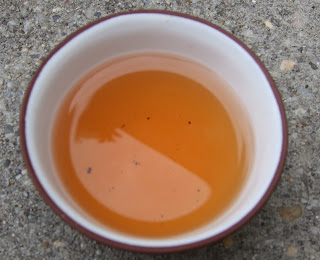Background:
Location: Zhu Shan, Nan Tou, Taiwan
Fermentation/Roasting: 25%/High-fired roasting
Parameters:
7 grams for a roughly 100 ml yixing teapot
15 seconds for first three steepings, increased 10 seconds for each additional steeping
Dry Leaf appearance:

The appearance of the tea is very dark, and although the tea leaves in this photo are crushed (it was towards the end of the 1 0z I purchased) the leaves seemed tightly bound. There was a rich and roasted aroma. The pellets seemed to be roasted well, because they crushed well when I rubbed it between the fingers.
 The first couple of steeps had a very bold and rich aroma, and the high-fire roasting gave it a very fruity flavor that I enjoyed, but was somewhat overpowering at times. During the second steeping I noticed hints of chocolate and spiciness in the tea liquor. By the third and fourth steeping the fruity notes were not as potent, and the tea was becoming mellower and smoother. There was also slight woodsy aroma detected from the 4th steeping. The tea liquor was very clear, with a wonderfully rich color. The color reminds me of autumn for some reason.
The first couple of steeps had a very bold and rich aroma, and the high-fire roasting gave it a very fruity flavor that I enjoyed, but was somewhat overpowering at times. During the second steeping I noticed hints of chocolate and spiciness in the tea liquor. By the third and fourth steeping the fruity notes were not as potent, and the tea was becoming mellower and smoother. There was also slight woodsy aroma detected from the 4th steeping. The tea liquor was very clear, with a wonderfully rich color. The color reminds me of autumn for some reason.Conclusion:

All in all, this was a very nice tea; however, some people may not like it because the high-fire roasting adds potent fruitiness to the tea. But I'm a big fan of roasted teas, because the teas have a bold flavor to it. The astringency was very nice, and it lingered on my tongue for a good hour or two. If I were to buy this tea again, I might age it so that time cuts the fruitiness, and the flavor will mellow out.
Post-Note: I took the trouble to actually go outside for these photos, so hopefully they're a clearer guide. Initially I got awkward glances as I took pictures of wet tea leaves outside my dorm. I think I have a reputation for being the resident tea-maniac, but that's compliment for me.








5 comments:
I've been curious about this tea for a while, so I'm glad you posted about it. Does it have a strong charcoal taste because of the roast?
Thanks,
Brent
Although it went under high-fire roasting, it doesn't have a strong charcoal taste like you would find in darker Wuyi Yen Cha. There are notes of honey and caramel, but no charcoal
Awesome, I'll have to try it then. I like roasted teas as well, but too much charcoal can be nasty. Thanks for the review!
Brent
Ohhhhh, I just discovered a new blog!
Things are looking lovely, keep up the good work.
Very nice blog and very interesting reviews! The bergamot (fo shou) oolong I recently had, loose leaves look greener than yours (but I heard that your redder kind is more upscale). Mine doesn't have too much roast taste but does have some tannin taste (which I don't mind but I suspect that more expensive kind will have lighter tannin taste). Btw, did you check the wet leaves after brew? Sometimes after brewing, I enjoy picking on the wet leaves and see if they are thick and complete :D
Post a Comment